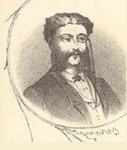A localised and updated adaptation of W. M. Akhurst's 1869 pantomime The House that Jack Built, or, Harlequin Progress and the Loves, Laughs, Laments and Labors of Jack Melbourne and Little Victoria (Theatre Royal, Melbourne), with incidental music (including the overture) by Walter Rice.
The pantomime contains numerous hits at local identities, issues, and events. Of this aspect of the production, Richard Fotheringham writes:
'Since before 1820 the 'House that Jack Built' story had been used for political commentary. Akhurst follows this tradition in making his hero Jack Melbourne and Little Victoria represent the hopes and fears for the future of that colony and his villain Orognome some of its current vices, particularly unscrupulous and fraudulent manipulation of mining stocks and share trading 'Under the Verandah'. The Sydney localiser found no reason to alter this element, apart from substituting a few more recent financial scandals or ones closer to home' (Australian Plays for the Colonial Stage, pp.220-21).
There does appear, however, to be a less explicit celebration of local achievements in this production.
The story concerns Jack Sydney, who has been raised and educated by the Fairy Queen Diamantina in an attempt to foil the evil plans of Orognome (the Gold Sovereign). Some years previously, Orognome kidnapped Little Australia,to prevent her from bringing to fruition a prophecy made at her birth, which foretells that she would 'rule half the earth'. Diamantina's plan is that Jack will improve the land upon which 'his lot has been cast', thereby countering Orognome's intentions. However, being both mortal and a young man just on eighteen, Jack begins exhibiting desires to move beyond the fairy cave he has lived in almost all his life. He digs a hole that eventually leads him to Orognome's home, where he meets and falls in love with Little Australia. The Gold Sovereign drugs Jack and leaves 'him in a critical position on the line over which the gold trucks pass'. He is saved from being crushed (in a burlesque of Dion Boucicault's After Dark) by Joey, 'a marsupial attendant upon Little Australia and who possesses 'largely cultivated instincts.' With the aid of Diamantina, Jack and Little Australia make their way to the surface, where Jack is required to build a house and make history in order to defeat Orognome. Although he succeeds in erecting his house (it turns out to be the House of Parliament) and presenting a panorama of Sydney's history from 1835 to the present day, Jack does not prosper from his handiwork. He is later found outside the house, where Orognome, disguised as a stockbroker (an 'under the Verandah Man'), swindles him through bogus land and mining speculation. Jack is once again saved by Diamantina, however, before being conveyed, along with Little Australia and Joey, to the 'Golden Conservatory and Temple of Gems', where the transformation scene takes place.
(Plot synopsis cited in Age 28 December 1869, p.3; Australasian 1 January 1870, p.18; and Sydney Mail 30 December 1871, p.1395).
The scenes presented were:
Act 1.
Scene 1. The Haunted Dell of Diamonds with Fairy Castle in the Air.
Scene 2. The Superficial Deposits and Stratified Rocks Leading to the Great Suburb of Horrifferousquartzton.
Scene 3. Palatial Caverns of Orognome.
Scene 4. The Dell of Diamonds (Revisited).
Scene 5. The House that Jack Built.
Scene 6. Exterior of the New Post Office.
Grand Transformation Scene and Harlequinade:
Act 2.
Scene 1. Post Office, Sydney.
Scene 2. Turner's Market Cloth Hall, 484 George Street, and Lemaire's Toy Shop.
Scene 3. A Well Known Spot in Hyde Park, Sydney.
Scene 4. G. H. Smith, Hatter, George Street.
Scene 5. The Loviathon Plum Pudding.
Scene 6. Silver Trelliced Dell in the Australian Fernery.
Songs incorporated into this production included the opening from the opera Pipele (by Serafino De Ferrari), 'Dada' (solo and chorus), 'Popsy Wopsy' (duet), 'Wind Up Galop' (duet and chorus), 'The Style to Which It's Done' (topical song), 'Rollicking Rams' (chorus), 'Chickaleary Bloke', 'Ring the Bell, Watchman', 'See at Your Feet' (trio), 'Fair Land of Poland' (solo), 'Through the World' (trio), 'Meet me in the Lane', 'Cruel Jane Jemima', 'J'aime les Militairs', 'Cork Leg', 'Mary Holder', 'Burlington Arcade' (duet), and 'Hot Coddlins'.


